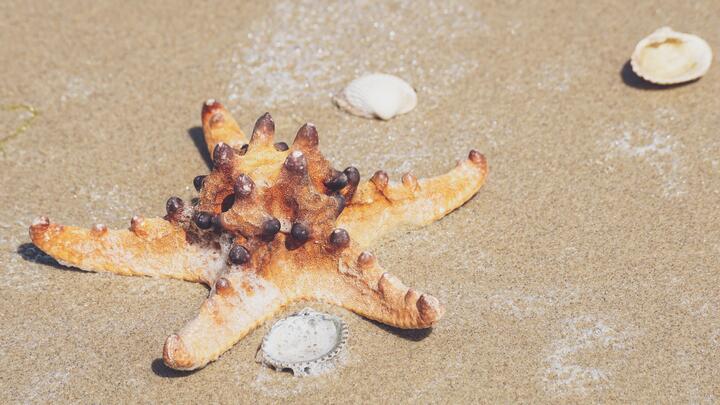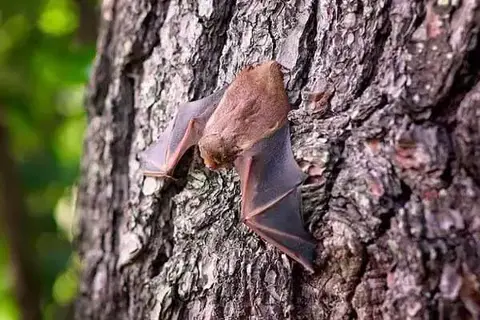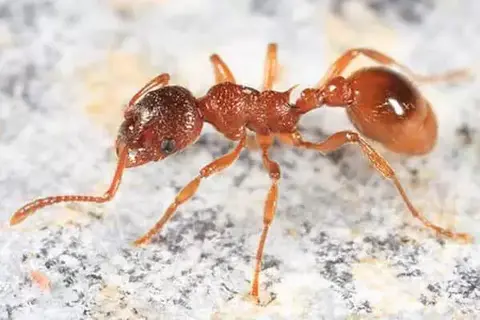Starfish Characteristics And Facts
Murphy ScottThe starfishes are found at different depths; some species live at depths of thousands of meters, others near the coast, sometimes remaining at low tide for a few hours without water.
 Photo by Susanne Jutzeler, suju-foto on pexels
Photo by Susanne Jutzeler, suju-foto on pexelsThe starfish are enduring in many respects, but (like other echinoderms) are extremely sensitive to the degree of water salinity, requiring water of normal ocean salinity (about 3%).
Starfish can reach large sizes, up to 70 cm and more from the end of one ray to the end of the opposite; often bright and motley colored. The number of species is over 1700.
Structure and physiology. The body of the starfish has the form of a five-beam star, which distinguishes a central disk and five rays, or hands. However, some stars have more than five rays: with six (Hexaster) or with nine, eleven, thirteen rays, or more. A particularly large number of rays (more than 30) have stars from the Brisingidae family.
For the convenience of orientation in the body of needle-skinned people distinguish, firstly, the lines going from the center to the end of the rays, called radii or radial lines; secondly, the lines ending at the edge of the disk between adjacent rays, which are designated as interradial lines.
The star body is flattened in the direction of the symmetry axis. The mouth (the oral side) is placed in the center of one of the flat sides and the powder (the abnormal side) in the center of the other side. The animal crawls at the bottom of the book with its mouth. Crawling is performed with the help of special spurs, ambulacral legs, located at the bottom of the ambulacral furrow on the lower (oral) side of each beam.
The wall of the body consists of a single, usually lumbar epithelium and a layer of underlying connective tissue; under the connective tissue lies the peritoneal epithelium, limiting the secondary cavity of the body, or the whole, in which all the innards are placed.
In the subcutaneous connective tissue, the lime skeleton develops first in the form of microscopic bodies, which later merge into larger and properly placed plates. The skeleton is more strongly developed on the oral, and mouth sides of the body. In each beam, there are two rows of ambulacral plates, which are connected in pairs and cover, like a gable roof, the ambulacral furrow of the mouth (oral) side.
The skeleton of the abnormal side is mostly represented only by numerous narrow lime bars. Among them, in one of the interradiuses of the disk stands out quite large, sometimes painted differently than the rest of the disk, Madreporite plate, permeated with numerous small holes. Spikes, small lime needles, etc., depart from the surface of the skeleton records. Some stars have short curved lime needles that can join like two halves of scissors and form so-called pedicellaria. Pedicellaria is opened and closed by a system of special muscles. All the muscles in the needle-skin are smooth.
The digestive system begins in the center of the oral side of the disc with the mouth, which is surrounded by a soft annular lip. There are no special organs of food grabbing and grinding. The mouth is informed by a short esophagus with a large folded, mark-shaped stomach occupying the inside of the disc. The stomach passes into the short and narrow back intestine (often with a special rectal gland), which opens in the center of the abnormal side of the disk. From the stomach to the whole rays depart 5 pairs of long blind protrusions, planted with side growths.
The starfish are big predators. They feed on various invertebrates, but mainly attack sedentary forms, such as bivalves, sea urchins, etc. Small prey of the star is swallowed in its entirety, and to master the large one, the stomach is turned out through the mouth and put it on prey; digestion of the latter goes, thus, outside the body of the predator. Gathering on oyster shoals, the stars exterminate large amounts of these shellfish.
The nervous system is primitive. It lies almost entirely in the outer epithelium. The main part of the central nervous system consists of an oral epithelial thickening, or nerve ring, and then departing from it five radial nerves, located at the bottom of the ambulacral furrow. The nerves reach the end of the rays. Deeper, under this superficial nervous system, in each ray passes a double, weaker deep radial nerve.
Sense organs. Touch organs are ambulacral legs and five short tentacles at the ends of the rays. At the base of the tentacle lies on the eye; the eyes are arranged simply, by the type of eye dimples and can only determine the brightness of the light. Asteroidea seems to have a sense of smell: they crawl in an aquarium behind a moving piece of meat and after artificial removal of the eyes.
Ambulacral system. The movement takes place with the help of an ambulacral system – a system of canals filled with aqueous fluid. It begins on the abnormal side of the disk with a madrepore plate. Plate pores lead to a special rocky channel, the walls of which contain lime. The canal descends to the oral side of the body and here falls into the occipital ring canal, which lies under the stomach. Five radial ambulacral canals, giving side branches, start from the circular channel. Each branch sends to the oral side of the canal leg, which passes between the ambulacral plates in one of the legs, and inside the body gives a small hollow ampoule. The ambulacral legs are hollow, very stretchy muscular growths, equipped with a small suction cup at the free end. The legs sit in 2 or 4 rows at the bottom of the ambulacral grooves of rays. Movement is carried out in the following way. Extended legs attach suction cups to the substrate. Then the musculature of the legs is reduced, fluid from the legs is pushed into the appropriate ampoules, and the legs themselves are greatly shortened. As a result, the animal is slightly pulled up on the sucked-up legs in the direction of movement. Then the legs are detached from the substrate, the liquid is again pumped into them by reducing the ampoules, they are pulled out in the direction of movement, are again sucked to the bottom, etc.
The speed of motion of sea stars (as well as other needle-skinned stars) is small: a sea star crawls no more than 5-8 cm per minute.
Respiratory organs. The ambulacral system also plays a role in the stars’ breathing, but the main respiratory organs are the skin gills. These are short thin-walled protrusions of the body wall, in which the continuation of the whole goes. They are found mainly on the abnormal side of the animal, as well as on the sides of the ambulacral furrow. Through the walls of the gills, the oxygen dissolved in seawater diffuses into the whole liquid. The latter is transparent, colorless, and contains numerous amoeboid cells.
The blood system. Inside the septum, which lies in the perihemal channels, placed lacunae of the blood system. They are united by a peri-mouth ring. Also, there is an abnormal blood ring, connected through the so-called axial organ with the perioral.
In contrast to the perihemal system lined with peritoneal epithelium, the blood system is a system of a lumen in the connective tissue (lacuna), deprived of its own epithelial lining. The liquid is accumulated mainly through the intake of nutrients from the intestinal wall into the lacunas located here. Thus it corresponds not so much to the blood as to the lymph of the higher vertebrates, i.e. it carries nutrients through the body.
Extraction. No special organs of excretion. A large part of the metabolic products formed in the body is excreted with the help of amoeboid cells scattered in a fluid that fills all cavities of the body. At injection as a whole, finely broken carcass amoebocytes are loaded with paint grains and leave the body through its covers. At the same time, they select the thinnest parts of the body wall, namely, the skin gills; whole accumulations of amoeboid cells loaded with ink and normal secretion products go through them. Some of the excreta is directly deposited in the skin and other tissues as clusters of yellow grains, etc. The stock of amoeboid cells in the body must be constantly replenished. For this purpose, special lymphatic organs serve tideman glands and axial organs.
The sexual system is simple. Sea stars are separated by sexes. The sex glands have the form of branched pouches, lying in pairs at the base of the rays and opening up to the outside through short channels between the rays. Sex products are brought into the surrounding water, where fertilization takes place.
The starfish has a highly developed regeneration capacity. A new one grows in place of a torn off beam. A cut off a beam of some stars can recover a new star on the damaged end. Some stars (Linckia) have a spontaneous process of disintegrating the animal into separate rays and subsequent regeneration so that the regenerative capacity leads to barren reproduction.
Classification and propagation. The Starfish class, which includes 3 units, has a practically worldwide spread. Sea stars inhabit all parts of the world ocean with normal ocean salinity, but they are particularly rich in tropical waters: in coastal zones, on shoals and banks, on coral reefs, etc. Stars unite polyps, and dead reef areas are rapidly destroyed by surf. This group is quite widely represented in the temperate and northern regions of the globe, where the common multi-beam stars from the family Solasteridae. In the Far Eastern seas, often found forming large clusters on shoals Patiria – a blue star with orange spots, which has the shape of a pentagon with slightly concave edges. In the same areas are also common representatives of the third unit – Forcipulata, which has very flexible rays and characteristic pedicellate, consisting of three movably articulated skeletal elements.
Starfish Facts – What Are the Characteristics of a Starfish?
 Photo by Efe Yağız Soysal on pexels
Photo by Efe Yağız Soysal on pexelsStarfish have several unique characteristics. They are small, have hard outer skin, and lack eyes and brains. The body is shaped like a disc with five arms and a central disc. They also have digestive glands, and the arms have duplicates of the major organs. This is a crucial characteristic for survival. Even if the body is eaten by a predator, starfish can regenerate by growing a new set of legs.
Starfish differ in color from one species to another, ranging from light to dark. This allows them to hide from predators while attracting a mate. The varying colors give them a variety of personality traits. They are also tough, with calcium-rich tissue protecting them from predators. The skin is smooth on some starfish, while others have pimples or spines on their body. The larger starfish have a harder outer shell.
Despite their tough appearance, starfish regenerate body parts as they die, although this process is slow. It can take a year for the starfish to grow a full skeleton, depending on the species. They also have two stomachs, which can be pushed out of their body during feeding. They have light-sensitive spots on their arms. Eventually, starfish lose their exoskeleton, which is made of calcium carbonate.
The heart of the starfish is located in the middle of the oral disc. It is bordered by a membrane known as the peristomial sphincter. The heart has several folds that can expand the surface. They also have different ligaments that provide access to the pyloric caeca. The anus is where the digestive glands are located. They can consume fecal matter and decompose vegetables.
Starfish have a complex digestive system. They eat outside their bodies. However, some species are predatory and must be protected from predators. Nevertheless, starfish have many uses. They are used in food, cosmetics, and pharmaceuticals. They are considered beneficial for our health. Aside from their amazing ability to grow, starfish are also unique in that they are symbiotic with other organisms.
They are detritivores, meaning they feed on fecal matter and decomposing vegetables. They can regenerate parts of their bodies if they are injured or killed. In addition to their ability to regenerate, starfish have an array of other characteristics. They are bloodless and brainless, but they can regrow lost body parts and regenerate in their natural environment. A common feature of a starfish is its upper, textured skin. They tend to be smaller than their counterparts.
All starfish species are radially symmetrical and have tube feet filled with seawater. Unlike most animals, starfish do not have separate excretory organs. Instead, they remove their waste by diffusion through their legs and papules. Some species have conspicuous marginal plates on their arms and disc, which help them breathe air. Some species have unusual morphologies. The crown-of-thorns sea star is a special example.
They are carnivorous and scavengers. They feed on small animals, but can also consume large animals like mussels and oysters. While starfish are not carnivorous, they do have a basic nervous system. They can move away from danger. The body of a starfish is flexible. They can grow in various sizes and colors, depending on the type of prey they ingest.
The body of a starfish is calcified and has spines on the outside. This makes them a tough animals. Their calcified exterior makes them resistant to damage. Their arms are very adaptable and can regenerate if they are damaged. Their nerve network, which is similar to the human central nervous system, helps them move and swim. They are a scavenger, but they are not parasitic.
The body of a starfish is flexible, and it can live in many different environments. Their radially symmetrical bodies make them very difficult for other animals to detect. They are also characterized by their spongy, radial symmetry, and a spongy substance called chitin. Their spongy, non-sticky bodies can be a good source of anti-inflammatory substances.
- WildlifeHow Often Do Deer Have Babies?

- LivestockCan Goats Eat Grapes?By Amelia B

- Insects20 Interesting Facts About ButterfliesBy Lucas Torres

- Wildlife20 Interesting Facts About BatsBy Khai Dove

- InsectsInteresting Facts About Fire AntsBy Charlotte Green

- DogsCan Chinchilla Eat Carrots?By Karla Miller

- DogsHow To Choose Dog Shoes For Walking?By Khai Dove

- Livestock20 Interesting Facts About CowsBy Murphy Scott

- CatsWhy Cat Food Is Bad For DogsBy Evelyn Star

- RodentsWhat Do Lemmings Eat?By Amelia B
